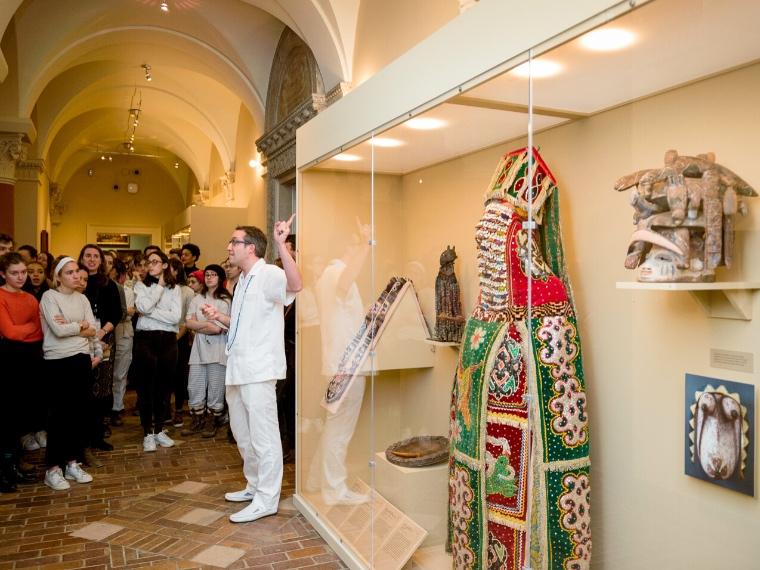Art History
Academic Program in Art History

Assistant Professor Matt Rarey discusses the objects in an installation of African art at the Allen Memorial Art Museum, which was curated by students who took his course, African Art in Museums: From Collection to Display.
Photo credit: Yevhen Gulenko
Program Requirements
Courses in art history cover the arts of Africa and the African diaspora, East Asia, Europe, Islamic cultures, and the Americas from prehistory to the present day.
With this breadth of curriculum, art history majors become aware of diverse modes of visual communication; varied cultural and historical conditions that result in different artistic traditions, subject matters, spatial experiences, and attitudes about art and architecture; and different methods and theories of conducting art historical analysis.
Curriculum Overview
Most art history courses are discussion-based and students make frequent visits to the Allen Memorial Art Museum (AMAM). We offer courses at three different levels.
Introductory courses provide a broad introduction to the field as an intellectual enterprise and core skills in analysis. After taking any 100-level course, students are well set up to take an intermediate-level (200-level) course in any area of art history. Our 300-level courses teach advanced-level skills in art history. These are seminars with 15 students or fewer. Typically, 300-level courses are theme-based and focused on a specific area within art history.
We also offer a yearlong Honors Program and first-year seminars; however, first-year seminars satisfy none of the requirements for completing the major in art history and may not be applied toward major/minor credit.
Requirements for the Major
Majors take one or two introductory-level (100-level) courses, four intermediate-level (200-level courses), and two advanced (300-level) seminars. Methods of Art History is a required intermediate-level course for all majors. This course introduces students to some of the most important methods of art history currently being practiced. It also makes majors self-conscious about art history as a discipline and gives them a methodological toolbox for their own research and thinking.
Majors are required to take at least one class in studio art to get first-hand experience of artistic practice. At least one year of a world language is also required. This emphasizes the importance of cultural and linguistic sensitivity for understanding the art and architecture of different cultures, and provides students with practical skills for advanced undergraduate study in art history, which often depends upon written sources in other languages. It also sets our graduates apart when applying for art history-related internships, jobs, and fellowships.
In addition to language study, majors must take two courses outside the department that complement their primary area of interest within art history. Students can deepen their understanding of the political, social, religious, theoretical, philosophical, literary, and or historical context of the art in which they are most interested.
Opportunities for Art History Majors
Study away: Many of our students study away in their third year. We encourage them to focus on advancing their language skills abroad. Recent art history majors have studied away in Senegal, Taiwan, Cuba, Japan, France, Germany, Italy, the Netherlands, and Spain.
Winter term: Many majors do valuable experiential learning through winter term projects. These projects are often set up and coordinated by art history faculty who connect students with alumni working in the art world. Recent projects include working with a conservator on outdoor sculpture in Los Angeles, a curator at the Brooklyn Museum, in the education department at Mass MoCA, with a private art collector, and at a museum in Taiwan. Another project in Taiwan involved creating a digital zine in Taipei about the experiences of LGBTQ+ activists, artists, and academics following a rise in opposition toward the legalization of same-sex marriage. It received funding by an in-Asia grant from Oberlin Shansi.
Experiential learning: Many art history majors work at the AMAM as curatorial assistants and docents during the academic year and summers. Students also gain curatorial experience in their art history coursework.
Majors often attain summer internships at museums and art-based organizations in the United States and abroad. One recent major worked as a curatorial intern at the Maruki Gallery for the Hiroshima Panels in Saitama, Japan, thanks to an in-Asia grant funded by Oberlin Shansi.
Additionally, students pursue independent research projects through their coursework, Mellon Mays Undergraduate Fellowships, Oberlin College Research Fellowships, and Honors under the guidance of a faculty mentor.
After Oberlin
Oberlin’s art history graduates pursue diverse careers. Many go into museum work as curators, educators, archivists, and art librarians or work as independent curators or in arts non-profits. Art history program graduates Dessane Cassell ’14 and Emma Ellis ’18 are among the many Oberlin students to receive the highly competitive Fulbright fellowship immediately after graduation.
Those who continue their studies after Oberlin complete graduate degrees in art history at such prestigious universities as Columbia, Chicago, Harvard, the University of Michigan, and New York University.
Others become teachers, lawyers, rare book librarians, journalists, UX designers, social workers, and public health practitioners.